Mount Leader
Houses within 15km of this house
Displaying 29 houses.
Houses within 15km of Mount Leader
Displaying 29 houses.
| House name | Description | |
|---|---|---|
| Cloonts | Henry Moriarty Cronin was leasing this property from the Kenmare estate at the time of Griffith's Valuation, when it was valued at £5 10s. Bary states that it was later occupied by Daniel O'Halloran but is no longer extant. | |
| Knocknaseed | Christiana Duggan (nee Cronin) was leasing Knocknaseed House from the Kenmare Estate at the time of Griffith's Valuation, when it was valued at £16. Bary states that the current house was built around 1839, replacing an older house on the site. It is still extant. | |
| Shinnagh House | Daniel Coltsman Cronin was leasing Shinnagh House from the Kenmare Estate at the time of Griffith's Valuation when it was valued at £14 8s. In 1837, Lewis refers to "Shannagh House" as the seat of H.O'Sullivan. Bary indicates that it was occupied by the Sullivan family for much of the nineteenth and into the twentieth centuries. It later passed by inheritence to the O'Keeffe family. | |
| Rath More House | At the time of Griffith's Valuation, Rev. Edward Walsh was leasing this property from Daniel Coltsman [Cronin], when it was valued at £17. In 1837 Lewis notes that Rathmore House was the property of D. Cronin but "now occupied by a society of monks". These were Cistercian monks, afterwards located at Mount Mellerey in county Waterford. The Cronins had lived at Rathmore until the early years of the nineteenth century before leasing it to the Order. After the monks departed it was used as the local presbytery and part of it is still extant. Denis Glissane was leasing a house in the same location from the Cronin estate, valued at £8. | |
| Knockagallane | This house valued at £10 was in the occupation of Eugene McCarthy at the time of Griffith's Valuation and held from - Morrison. | |
| Dromagh Castle | In 1815 Smith refers to Mr Philpot inhabiting Dromagh. A seat of the Leader family in the 19th century, Lewis writes that the castle was once the chief residence of the O'Keeffes. In 1906 buildings at Dromagh were valued at £27 and William N. Leader was the occupier. Donnelly states that it was burnt in March 1921 during the War of Independence. It is now a ruin. |
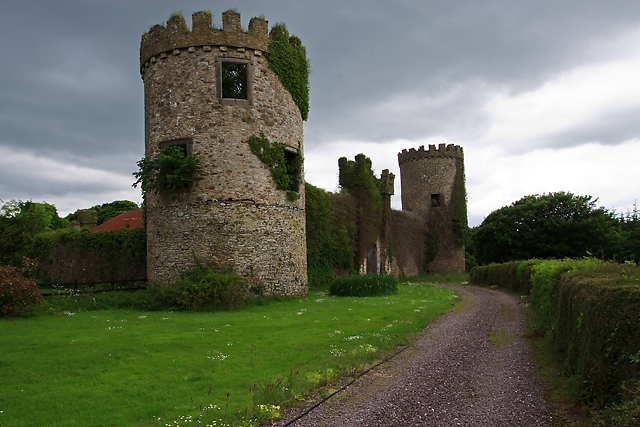
|
| Dysert | A house valued at £12 and held by Nicholas P. Leader in fee at the time of Griffith's Valuation. This house was still in Leader occupation in 1906. A house and farm are still extant at the site. | |
| Fort Grady | Located on the O'Grady, Viscount Guillamore estate, Fort Grady was valued at £14 in the mid 19th century and occupied by John O'Connell. In 1837 Lewis describes it as a farm house formerly the residence of the father of Viscount Guillamore. In 1814 it was occupied by Mr Daniel McAuliffe. In 1786 Wilson refers to it as "Knockbrack, the seat of Mr. Gredy". A house and farm are still extant at the site. | |
| Nashville/Rosnalee | This house was originally known as Nashville and was the home of the family of that name in the 18th century. Wilson refers to it as Nashville, the seat of Mr. Nash, in 1786. It passed by marriage to the Leader family. Nicholas P. Leader occupied the house in 1814. It was still known as Nashville in 1837 but is marked on the first Ordnance Survey map as Rosnalee. Valued at £51 at the time of Griffith's Valuation it was held by William Leader in fee and he had a flour mill nearby valued at £45. The Leaders still occupied this house in 1921. In 1943 the Irish Tourist Association Survey noted it as having been the chief seat of the Leaders, a two-storey spacious structure which was then unoccupied. It is no longer extant. | |
| Keale House | The seat of a branch of the Leader family in the 18th and 19th centuries, sold by them in the early 20th century. The buildings were valued at £22+ in the mid 19th century and the property was held by John Leader from Thomas G. French. The National Inventory of Architectural Heritage suggests the present house was built in 1834. It is still extant and well-maintained. |
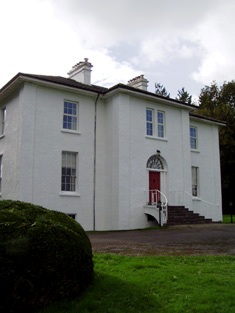
|
| Killeenleagh | No demesne was marked in this townland on the first Ordnance Survey map but a house valued at £15+ was situated there by the time of Griffith's Valuation. It was occupied by Richard O'Callaghan and held from the Earl of Listowel. | |
| Ardnageeha | Hajba writes that this house was built by Daniel McCartie, a Commissioner of Tithes for the parishes of Cullen and Drishane. The house valued at £12.10 shillings was occupied by his wife Anne McCartie at the time of Griffith's Valuation. The property was held from the Earl of Egmont. Daniel's only child Mary married John Maurice O'Connell, a grandson of Daniel O'Connell. The O'Connell lived at Ardnageeha until 1890 when they moved to Derragh House. The house is still extant though possibly not occupied. |

|
| Derragh | This house was the home of Denis McCartie in the first half of the 19th century. In the occupation of the Poor Law Guardians at the time of Griffith's Valuation when it was valued at £12+ and held from his widow Ellen McCartie. Later occupied by John and Mary O'Connell formerly of Ardnageeha. The house was demolished in the 1950s. | |
| Glantanemore | A house valued at £11 in Glantanemore was occupied by Robert McCartie in the early 1850s. He also held 309 acres in the townland from Charles D. Purcell and Captain Wood. This may be the house referred to by Hajba as Glantane House, Cullen, home of the McSweeneys in the 20th century. | |
| Church Hill | Occupied by Charles McCarthy in 1814 and by Daniel McCartie in 1837. Mary McCartie occupied the house in the early 1850s holding it from Anne McCartie. It was then valued at £5.10 shillings. Hajba writes that the last McCartie to live at Church Hill was Richard. The property was sold to the Shine family in the late 19th century and there are only some ruined remains of the house. | |
| Duarrigle Castle | Originally a tower house of the O'Keeffe family, leased by Henry Wrixon to Thomas Holmes Justice who built a 'mock' castle in the early 19th century. Inherited by his son Thomas Holmes Justice medical doctor of Mallow. Sold in the Encumbered Estates' Court in 1851 and bought by Henry Chinnery Justice, who left it to his sister Mrs Wallis when he died in 1859. The castle is now a ruin but the gatelodge is occupied. |
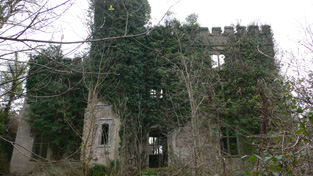
|
| Mount Justice | This was a home of the Justice family from at least the late 18th century. By the time of Griffith's Valuation the house was valued at £3.15 shillings and was occupied by John Bolton Justice who held it from Charles D. Purcell. Hajba writes that members of the Justice family continued to occupy the house until the 1920s. It is now demolished. | |
| Garrane House | This house is not marked on the first Ordnance Survey map. By the time of Griffith's Valuation however Henry Justice occupied a house valued at £11.10 shillings at Garrane West. He held the property from John C. Wallace [Wallis]. The home of members of the Twomey and O'Keeffe families in the 20th century and still occupied. | |
| Flintfield House | This house was a seat of the Chinnery family from the mid 18th to the mid 19th century. It was occupied by Barry Cotter in 1814 and by Denis O'Connell in 1837 and at the time of Griffith's Valuation. The buildings were valued at £18+ and the property was held from John Orpen. Home of the MacSweeneys in the 20th century. |
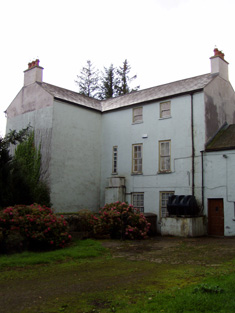
|
| Minehill | Home of a branch of the Wallis family in the early 19th century. Occupied by Denis McCarthy in 1814 and by John Cooke Wallis in 1837. By the time of Griffith's Valuation it was the residence of Francis Burton. The house was still home to the Burton family in the early 21st century. | |
| Rathroe | Hajba records a lease of Rathroe House from Sir Robert Deane to Denis McCarthy dated 1779. In 1837 another Denis McCarthy was occupying the house and he was also resident in the early 1850s when the house was held from the Reverend Nicholas Chinnery. The buildings were valued at £26.15 shillings. Hajba writes that the McCarthys continued to live in the house until it was sold in the 1930s to Con Meaney TD. The house is no longer extant. | |
| Mount Cross | This was the home of the Pearson family, held from Edward Townsend, inhabited by Mrs Pearson in 1837 and John Pearson in the early 1850s, when the buildings were valued at £11. Mary Pearson of Mount Cross owned 199 acres in county Cork in the 1870s. Archives relating to the Pearson family are located in Leeds University Library. The National Inventory of Architectural Heritage suggests the house was originally built by a Mr. Godfrey, a local mill owner, in the early eighteenth century. |
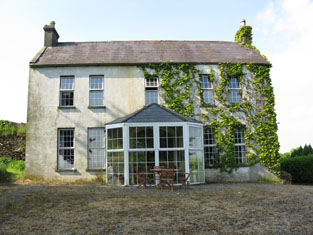
|
| Coolemore | This was the residence of Herbert O'Donnell in 1837 and in the early 1850s. Located on the Wallis estate it was valued at £20. Hajba writes that O'Donnell was agent to the Wallis estate and that it was later the home of the Perry family. A house is still extant at this site. | |
| Drishane Castle | Originally a MacCarthy castle, granted to the Hollow Sword Blade Company at the end of the 17th century, it was acquired by Henry Wallis from county Waterford in the early decades of the 18th century. William Wallis built the house near the castle soon afterwards and it remained in Wallis possession until the early 20th century. In 1894 Slater noted it as the seat of Aubrey J Wallace [Wallis]. The Sisters of the Infant Jesus, a French order of teaching nuns, occupied the house for most of the 20th century. In 1944 the Irish Tourist Association Survey outlined a history of the castle and the sale to the nuns. The castle is still extant. |

|
| Coomlogane | A late 18th century house was built near the original building. In 1786 Wilson refers to it as the seat of Mr. O'Leary. This house became the home of the McCarthy-O'Learys for all the 19th century. In the mid 19th century it was valued at £38. John McCarthy O'Leary occupied the house in 1906. It was looted during the War of Independence and is now demolished. | |
| Rathduane | The home of Owen McCarthy in 1814, of J.E. McCarty [Jeremiah Eugene] in 1837 and of Eugene McCarthy at the time of Griffith's Valuation when the buildings were valued at £20 and held from Sir Broderick Chinnery. Still a McCarthy home in the 1870s. | |
| Tullig | Henry Leader of Tullig died in 1834 and the Leader interest in this property came to an end. James Nash (died 1849) of Rockfield, Kanturk and of Tullig House, Millstreet is recorded in ''Burke's Irish Family Records''. At the time of Griffith's Valuation Tullig, valued £20 was occupied by the Reverend Charles Mangan and held from Jonas Morris. |
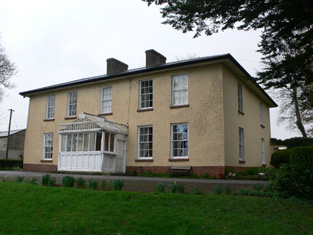
|
| Willow Brook | Occupied by Richard Orpin in the early 1850s and held from John Herbert Orpin, the buildings were valued at £10.10 shillings. This house is still extant and occupied. |

|
| Knight's Bridge & Glebe | In 1786 Wilson refers to Knight's Bridge as the seat of Sir John Conway Colthurst at Ballyvourney "near the nunnery". This may refer to the ruins of a monastic site dedicated to St. Gobnait. This area was in the possession of Sir George Colthurst at the time of Griffith's Valuation when Rev. Richard Kirchoffer was leasing a property valued at over £20. Buildings are still extant at the site. |

